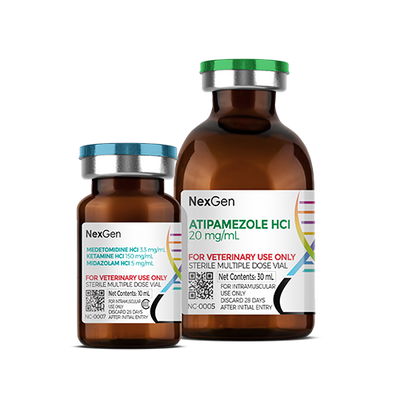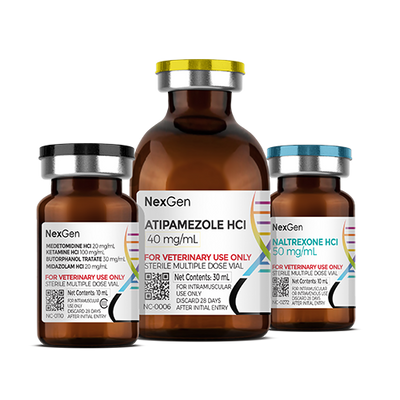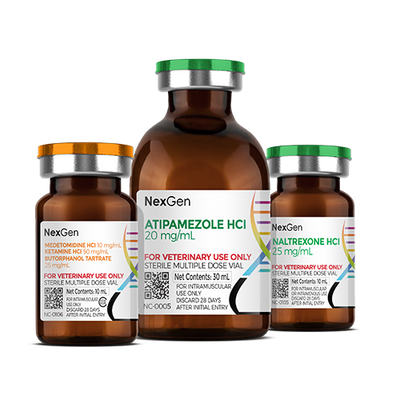
MK2™ Kit (Sedation & Reversal)
Login for pricing
- Brand
- Mixlab
- SKU:
- NC-0009K
- Product Type:
- Injectable
- Administration:
- Intramuscular
- Size:
- 30ml
- Controlled Substance:
- Schedule CIII
Anesthesia plays an important role in wildlife veterinary medicine, since the majority of the procedures carried out on wildlife species involve chemical restraint techniques.1 The ideal immobilization drug formulations for wild and exotic animals will have a wide safety margin, small volume for delivery, and will be fully reversible; thus, a small volume will facilitate rapid administration especially if remote delivery systems are used.1,2 Additionally, more concentrated anesthetics result in less tissue trauma due to decreased volume injected and will be absorbed faster, resulting in a quicker induction. Another consideration in drug selection for wildlife immobilization is a drug’s ability to be antagonized. Depending on the environmental conditions and target animal, rapid recovery at the desired time can be a huge advantage when immobilizing wildlife.
The refinement of drug formulations has been a dedicated concern of wildlife managers and veterinarians over the last several decades, and the premixed formulas available today are far superior to the on-the-fly drugs and formulations used in years past. Many formulations are also available with their ideal reversal agents, an indispensible component in the field.
The MK2™ Kit
The MK2™ Kit by NexGen Pharmaceuticals is a premixed formulation developed to provide veterinarians and wildlife handlers with a field-tested immobilization anesthesia option that can be effectively used to immobilize a broad range of exotic animal species. Medetomidine (10mg/ml) provides superior pain relief and muscle relaxation to other compounds employing α-2 adrenergic agonists, with ketamine HCL (200 mg/ml) supplying an effective paralytic. In combination, the two provide safe, smooth induction times and excellent recovery results. Atipamezole, a synthetic α2-adrenergic antagonist, is provided in the MK2™ Kit as a reversal agent.
With higher concentrations of medetomidine and ketamine than the MK Kit, the MK2™ Kit provides longer and deeper sedation, which translates into extended working time and quick recovery. This kit is recommended for larger-bodied cervids; it is also recommended for scenarios where longer working times and/or multiple procedures are required. Caution should be taken when the ambient air temperature exceeds 82 degrees Fahrenheit, as there is a high risk of hyprotherma if animal gets too hot while under sedation.
Delivery and Recommendations
For those who are new to utilizing MK2™ to manage their exotic animals, it is important to understand the level of anesthesia administered with Medetomidine/Ketamine sedation. MK2™ is a deep sedation, not to be confused with other sedations that are moderate.
The preferred route for the administration of an immobilizing drug by remote delivery is via intramuscular injection. The aim is to hit the animal in a specifically-selected site, causing injection into vascular tissue and facilitating rapid absorption of the drug. Not all areas of an animal's body are equally well-suited for injection by remote delivery; thus, the injection site should be carefully chosen.
The neck is generally a suitable site for large animals with muscular necks. Care should be taken to avoid hitting the jugular vein, the upper neck and the head. The ideal injection site is the trapezius muscle mass at the upper base of the neck. This injection site is suitable for species such as elk, moose, buffalo, bear, the equids and larger antelopes, rhinoceros, hippopotamus and elephant (if the ears can be avoided). Animals with slender necks, such as gazelle, gerenuk, giraffe and impala should not be darted in this area.
The shoulder is a suitable injection site in many larger species. This region is well-muscled, presenting a flat, perpendicular target. It is surrounded by relatively resilient areas and presents a fair-sized target in animals that are robust enough to be darted with remote delivery equipment.
To prevent the needle from becoming embedded in cartilage, the upper end of the scapula should be avoided. In sensitive species, the sight and smell of a dart in the shoulder may cause panic and flight. Some carnivores will destroy the dart by pulling it out with their teeth. The shoulder is not a suitable injection site for smaller species, due to their lesser size and limited muscle mass.
Where to buy the MK2™ Kit
The MK2™ Kit is available through NexGen Pharmaceuticals. Please consult your veterinarian prior to beginning any treatment regimen.
NOTE: This product is listed as a U.S. Drug Enforcement Administration (DEA) Schedule CIII Controlled Substance.
FOR RX ONLY: A valid prescription from a licensed veterinarian is required for dispensing this medication.
1West, G., et. al. Zoo Animal and Wildlife Immobilization and Anesthesia, Second Edition, John Wiley & Sons, Inc., July 2014.
2Arnemo, Jon & Kreeger, Terry. (2018). Handbook of Wildlife Chemical Immobilization, 5th Ed.
3Nielsen, L. Chemical immobilization of wild and exotic animals, Ames: Iowa State University Press, 1999.





















